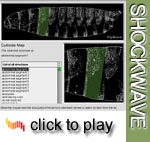Morphology of the epidermis
 The
epidermal pattern elements of the larva include setae, hairs and sensory
organs (sensilla), which have a characteristic topological distribution.
The cuticle pattern shows distinctive features in thoracic and abdominal
segments. Ventrally the cuticle forms a belt of small denticles at the anterior
border of each segment. Abdominal and thoracic denticle belts are easily
distinguishable, with those of the abdominal segments being broader and
more complex. Furthermore, the shape of denticle belts and distribution
of setae allows distinction of abdominal segments a1 and a8 from the remaining
abdominal segments as well as the thoracic segment t1 from t2-t3.
The
epidermal pattern elements of the larva include setae, hairs and sensory
organs (sensilla), which have a characteristic topological distribution.
The cuticle pattern shows distinctive features in thoracic and abdominal
segments. Ventrally the cuticle forms a belt of small denticles at the anterior
border of each segment. Abdominal and thoracic denticle belts are easily
distinguishable, with those of the abdominal segments being broader and
more complex. Furthermore, the shape of denticle belts and distribution
of setae allows distinction of abdominal segments a1 and a8 from the remaining
abdominal segments as well as the thoracic segment t1 from t2-t3.Denticles of abdominal segments exhibit a clear polarity in that the first and fourth rows are oriented anteriorly and all others posteriorly. In addition, denticles in each row have a characteristic size and shape. The denticle belts are roughly trapezoidal in abdominal segments a2-a7 and rectangular in abdominal segment a8. Dorsally the cuticle shows irregular rows of thin hairs; a single dorsal row of setae is present in the posterior half of segments a2-a7.
Media list